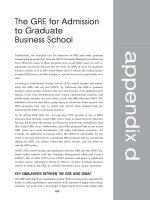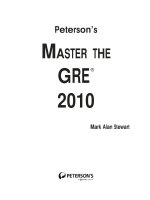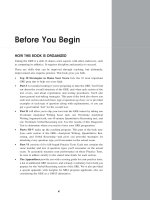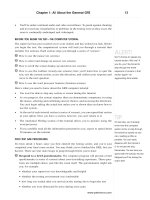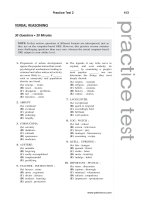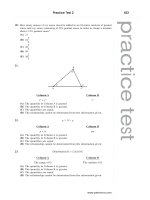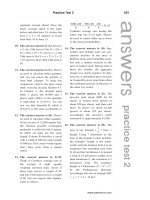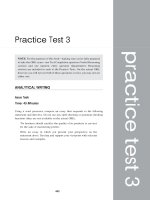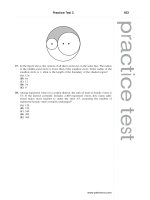Tài liệu Master the Gre 2010 - Part 48 docx
Bạn đang xem bản rút gọn của tài liệu. Xem và tải ngay bản đầy đủ của tài liệu tại đây (55.01 KB, 10 trang )
27. In the figure above, the centers of all three circles lie on the same line. The radius
of the middle-sized circle is twice that of the smallest circle. If the radius of the
smallest circle is 1, what is the length of the boundary of the shaded region?
(A) 12p
(B) 6p
(C) 12
(D) 3p
(E) 9
28. Among registered voters in a certain district, the ratio of male to female voters is
3:5. If the district currently includes 2,400 registered voters, how many addi-
tional males must register to make the ratio 4:5, assuming the number of
registered female voters remains unchanged?
(A) 120
(B) 150
(C) 240
(D) 300
(E) 360
practicetest
Practice Test 3 453
.................................................................
..............................................................................................
www.petersons.com
VERBAL REASONING
30 Questions • 30 Minutes
NOTE: In this section, questions of different formats are interspersed, just as
they are on the computer-based GRE. However, this practice session contains
more challenging questions than easy ones, whereas the actual computer-based
GRE adapts to your ability level.
1. ITINERANT:
(A) settled
(B) paralyzed
(C) fixated
(D) linear
(E) lethargic
2. WEAPON : INTIMIDATE ::
(A) memory : recall
(B) donor : give
(C) icebox : preserve
(D) sun : shine
(E) meal : serve
3. NATAL : GESTATION ::
(A) wealthy : investment
(B) conclusive : premise
(C) humble : conceit
(D) truthful : proof
(E) feeble : cowardice
4. INCREDULITY:
(A) truthfulness
(B) faith
(C) credibility
(D) loyalty
(E) reverence
5. The _______ and _______ lifestyle of
certain types of primates differs
greatly from the habits of most
primate species, who are active
during the day and who form soci-
eties based on quite complex interre-
lationships.
(A) sedentary . . omnivorous
(B) inactive . . monogamous
(C) nomadic..lonely
(D) nocturnal . . solitary
(E) diurnal . . gregarious
6. VIE:
(A) grow weary
(B) fall behind
(C) admit defeat
(D) reduce expectations
(E) change priorities
7. VERDANT:
(A) incomplete
(B) immature
(C) forbidding
(D) diminutive
(E) desolate
8. Personality is rooted as deeply in the
need for _______, or at least personal
interaction, as _______ well-being is
rooted in chemical needs.
(A) love . . physical
(B) hope..biological
(C) affection . . social
(D) self-respect..bodily
(E) companionship . . natural
PART VI: Five Practice Tests454
.................................................................
..............................................................................................
www.petersons.com
Questions 9–11 are based on the
following passage.
Late Victorian and modern ideas of
culture are indebted to Matthew Arnold,
who, largely through his Culture and
Anarchy (1869), placed the word at the
center of debates about the goals of intel-
lectual life and humanistic society. Arnold
defined culture as “the pursuit of per-
fection by getting to know the best which
has been thought and said.” Through this
knowledge, Arnold hoped, we can turn “a
fresh and free thought upon our stock
notions and habits.” Although Arnold
helped to define the purposes of the liberal
arts curriculum in the century following
the publication of Culture, three concrete
forms of dissent from his views have had
considerable impact of their own.
The first protests Arnold’s fearful desig-
nation of “anarchy” as culture’s enemy,
viewing this dichotomy simply as another
version of the struggle between a privi-
leged power structure and radical chal-
lenges to its authority. But while Arnold
certainly tried to define the arch—the
legitimizing order of value—against the
anarch of existentialist democracy, he
himself was plagued in his soul by the
blind arrogances of the reactionary powers
in his world. The writer who regarded the
contemporary condition with such appre-
hension in Culture is the poet who wrote
“Dover Beach,” not an ideologue rounding
up all the usual modern suspects.
Another form of opposition saw Arnold’s
culture as a perverse perpetuation of clas-
sical and literary learning, outlook, and
privileges in a world where science had
become the new arch and from which any
substantively new order of thinking must
develop. At the center of the “two cultures”
debate were the goals of the formal educa-
tional curriculum, the principal vehicle
through which Arnoldian culture operates.
However, Arnold himself had viewed
culture as enacting its life in a much more
broadly conceived set of institutions.
A third form is so-called “multicultur-
alism,” a movement aimed largely at
gaining recognition for voices and visions
that Arnoldian culture has implicitly sup-
pressed. In educational practice, multicul-
turalists are interested in deflating the
imperious authority that “high culture”
exercises over curriculum while bringing
into play the principle that we must learn
what is representative, for we have over-
emphasized what is exceptional. Though
the multiculturalists’ conflict with
Arnoldian culture has clear affinities with
the radical critique, multiculturalism
actually affirms Arnold by returning us
more specifically to a tension inherent in
the idea of culture rather than to the cul-
ture-anarchy dichotomy.
9. Based on the information in the
passage, Arnold would probably
agree that the educational cur-
riculum should
(A) focus on the sciences more than
the humanities
(B) strike a balance between
practicality and theory
(C) reflect the dominant culture of
the day
(D) be more rigorous than during
the past
(E) deemphasize what is represen-
tative
10. It can be inferred from the passage
that the two-cultures debate
(A) emerged as a reaction to the
multiculturalist movement
(B) developed after 1869
(C) influenced Arnold’s thinking
about culture
(D) was carried on by American as
well as European scientists
(E) led to a schizophrenic educa-
tional system
practicetest
Practice Test 3 455
.................................................................
..............................................................................................
www.petersons.com
11. The author’s primary concern in the
passage is to
(A) argue against those who have
opposed Arnold’s ideas
(B) describe Arnold’s conception of
culture
(C) explain why Arnold considered
the pursuit of perfection to be
the essence of culture
(D) trace Arnold’s influence on the
liberal arts educational cur-
riculum
(E) examine the different views of
culture that have emerged
since the eighteenth century
12. DECREE : INFORM ::
(A) fascinate : interest
(B) gallop : canter
(C) resign : quit
(D) endure : persist
(E) shout : whisper
13. CINNAMON : CONFECTION ::
(A) villain : tale
(B) cliff : plateau
(C) collar : cuff
(D) cell : prison
(E) flank : horse
14. Considering today’s high divorce rate
and growing number of single-parent
households, it is _______ that the
most Americans still adhere to the
_______ belief in the importance of
an intact nuclear family.
(A) surprising . . superficial
(B) encouraging . . obsolete
(C) interesting . . popular
(D) illuminating . . controversial
(E) astonishing..traditional
15. LATITUDE:
(A) conformity
(B) point of focus
(C) strictness
(D) inflection
(E) restraint
Questions 16–18 are based on the
following passage.
A certain strain of bacteria called
lyngbya majuscula, an ancient ancestor of
modern-day algae, is making a comeback
in ocean waters just off the world’s most
industrialized coastal regions. This
primitive bacteria has survived for nearly
three billion years due to a variety of sur-
vival mechanisms. It can produce its own
fertilizer by pulling nitrogen out of the air;
it relies on a different spectrum of light
than algae do, allowing it to thrive even in
deep, murky waters; and when it dies and
decays, it releases its own nitrogen and
phosphorous, on which the next gen-
eration of lyngbya feeds.
Lyngbya emits more than one hundred
different toxins harmful to other ocean life
as well as to humans. Commercial fish-
ermen and divers who come in contact
with the bacteria frequently complain of
skin rashes and respiratory problems,
which can keep these workers off the job
for months at a time. The bacteria further
disrupts local economies by blocking sun-
light to sea grasses that attract fish and
other sea life. Scientists attribute the
modern-day reappearance of lyngbya, and
the resulting problems, chiefly to
nitrogen- and phosphorous-rich sewage
partially processed at wastewater
treatment plants and pumped into rivers
that feed coastal ocean waters.
16. The passage as a whole can appro-
priately be viewed as an examination
of which of the following?
(A) The causes and consequences of
the re-emergence of lyngbya
(B) The possible means of halting
and reversing the spread of
lyngbya
(C) The economic impact of lyngbya
on certain coastal communities
(D)
The survival mechanisms and
life cycle of lyngbya
(E) The ecological fallout resulting
from coastal sewage runoff
PART VI: Five Practice Tests456
.................................................................
..............................................................................................
www.petersons.com
17. It can be inferred from the passage
that the lyngbya majuscula strain
has survived for billions of years
partly because it
(A) is threatened by few, if any,
natural predators
(B) emits harmful toxins that ward
off potential predators
(C) does not depend on light for its
existence
(D) possesses the ability to essen-
tially feed on itself
(E) adapts easily to changes in
water temperature
18. According to passage, the lyngbya
majuscula strain
I. depends largely on nitrogen and
phosphorous as nutrients
II. can harm other ocean life as a
result of its high toxicity
III. thrives mainly in waters where
algae is largely absent
(A) I only
(B) III only
(C) I and II only
(D) II and III only
(E) I, II, and III
19. PITH:
(A) frivolity
(B) bore
(C) surplus
(D) chasm
(E) tangent
20. RUNT : SIBLING ::
(A) athlete : league
(B) spade : suit
(C) veneer : shield
(D) penny : currency
(E) peephole : panorama
21. The high incidence of speech articu-
lation disorders among young
children suggests that such “dis-
orders” are _______ developmental
phenomena, since they generally
occur less frequently among _______
age groups.
(A) very serious . . most
(B) relatively rare . . certain
(C) actually normal . . other
(D) clinically acceptable . . younger
(E) commonly misunderstood . .
older
22. CARETAKER : ATTENTIVE ::
(A) hair : curly
(B) writing : legible
(C) mule : obstinate
(D) mansion : spacious
(E) meat : broiled
23. TRAVESTY : RIDICULE ::
(A) reproduction : copy
(B) treachery : reprieve
(C) speech : imitate
(D) language : understand
(E) forgery : deceive
24. The _______ of the judging process
might be compromised unless each
contestant is assigned a unique code
number by which he or she is solely
identified.
(A) accuracy
(B) finality
(C) authority
(D) impartiality
(E) decisions
25. SHORE : PRECARIOUS ::
(A) plane : irregular
(B) boil : tepid
(C) frequent : uninviting
(D) stiffen : pliable
(E) douse : damp
practicetest
Practice Test 3 457
.................................................................
..............................................................................................
www.petersons.com
